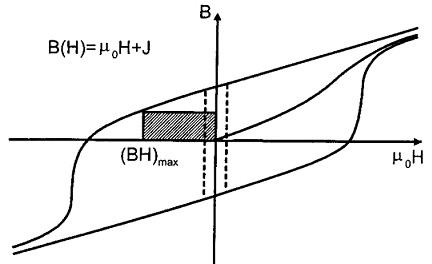maximum energy product on:
[Wikipedia]
[Google]
[Amazon]
 In
In
 The maximum energy product is defined based on the
The maximum energy product is defined based on the
magnetics
Magnetism is the class of physical attributes that are mediated by a magnetic field, which refers to the capacity to induce attractive and repulsive phenomena in other entities. Electric currents and the magnetic moments of elementary particle ...
, the maximum energy product is an important figure-of-merit for the strength of a permanent magnet
A magnet is a material or object that produces a magnetic field. This magnetic field is invisible but is responsible for the most notable property of a magnet: a force that pulls on other ferromagnetic materials, such as iron, steel, nickel, ...
material. It is often denoted and is typically given in units of either (kilojoules per cubic meter, in SI electromagnetism) or (mega-gauss
Johann Carl Friedrich Gauss (; german: Gauß ; la, Carolus Fridericus Gauss; 30 April 177723 February 1855) was a German mathematician and physicist who made significant contributions to many fields in mathematics and science. Sometimes refer ...
-oersted
The oersted (symbol Oe) is the coherent derived unit of the auxiliary magnetic field H in the centimetre–gram–second system of units (CGS). It is equivalent to 1 dyne per maxwell.
Difference between CGS and SI systems
In the CGS system, ...
, in gaussian electromagnetism). 1 MGOe is equivalent to .
During the 20th century, the maximum energy product of commercially available magnetic materials rose from around 1 MGOe (e.g. in KS Steel) to over 50 MGOe (in neodymium magnet
A hard_disk_drive.html"_;"title="Nickel-plated_neodymium_magnet_on_a_bracket_from_a_hard_disk_drive">Nickel-plated_neodymium_magnet_on_a_bracket_from_a_hard_disk_drive_
file:Nd-magnet.jpg.html" ;"title="hard_disk_drive_.html" ;"title="hard_disk_d ...
s). Other important permanent magnet properties include the remanence
Remanence or remanent magnetization or residual magnetism is the magnetization left behind in a ferromagnetic material (such as iron) after an external magnetic field is removed. Colloquially, when a magnet is "magnetized", it has remanence. The ...
() and coercivity
Coercivity, also called the magnetic coercivity, coercive field or coercive force, is a measure of the ability of a ferromagnetic material to withstand an external magnetic field without becoming demagnetized. Coercivity is usually measured in ...
(); these quantities are also determined from the saturation loop and are related to the maximum energy product, though not directly.
Definition and significance
 The maximum energy product is defined based on the
The maximum energy product is defined based on the magnetic hysteresis
Magnetic hysteresis occurs when an external magnetic field is applied to a ferromagnet such as iron and the atomic dipoles align themselves with it. Even when the field is removed, part of the alignment will be retained: the material has become '' ...
saturation loop (- curve), in the demagnetizing portion where the and fields are in opposition. It is defined as the maximal value of the product of and along this curve (actually, the maximum of the negative of the product, , since they have opposing signs):
:
Equivalently, it can be graphically defined as the area of the largest rectangle that can be drawn between the origin and the saturation demagnetization B-H curve (see figure).
The significance of is that the volume of magnet necessary for any given application tends to be inversely proportional to . This is illustrated by considering a simple magnetic circuit
A magnetic circuit is made up of one or more closed loop paths containing a magnetic flux. The flux is usually generated by permanent magnets or electromagnets and confined to the path by magnetic cores consisting of ferromagnetic materials l ...
containing a permanent magnet of volume and an air gap of volume , connected to each other by a magnetic core
A magnetic core is a piece of magnetic material with a high magnetic permeability used to confine and guide magnetic fields in electrical, electromechanical and magnetic devices such as electromagnets, transformers, electric motors, generators, in ...
. Suppose the goal is to reach a certain field strength in the gap. In such a situation, the total magnetic energy
Magnetic energy and electrostatic potential energy are related by Maxwell's equations. The potential energy of a magnet or magnetic moment \mathbf in a magnetic field \mathbf is defined as the mechanical work of the magnetic force (actually magnet ...
in the gap (volume-integrated magnetic energy density) is directly equal to half the volume-integrated in the magnet:
:
thus in order to achieve the desired magnetic field in the gap, the required volume of magnet can be minimized by maximizing in the magnet. By choosing a magnetic material with a high , and also choosing the aspect ratio of the magnet so that its is equal to , the required volume of magnet is minimized.
See also
*Tetrataenite
Tetrataenite is a native metal alloy composed of chemically-ordered L10-type FeNi, recognized as a mineral in 1980. The mineral is named after its tetragonal crystal structure and its relation to the iron-nickel alloy, taenite. It is one of the m ...
References
{{Reflist Magnetostatics Magnetism Magnetic ordering